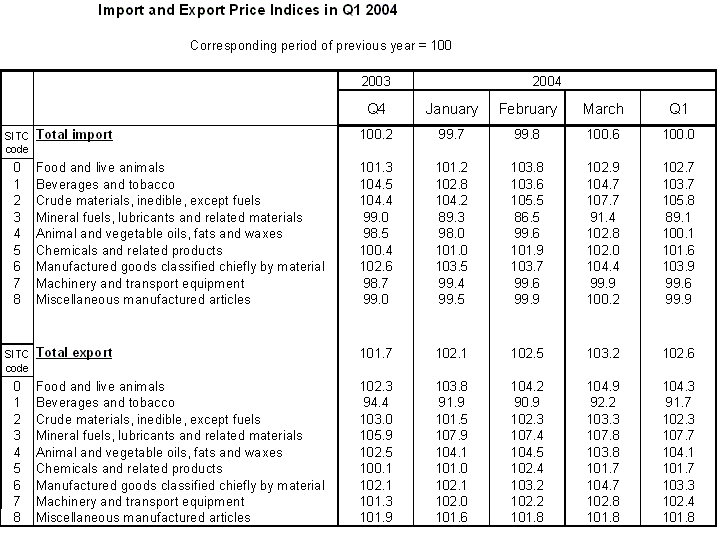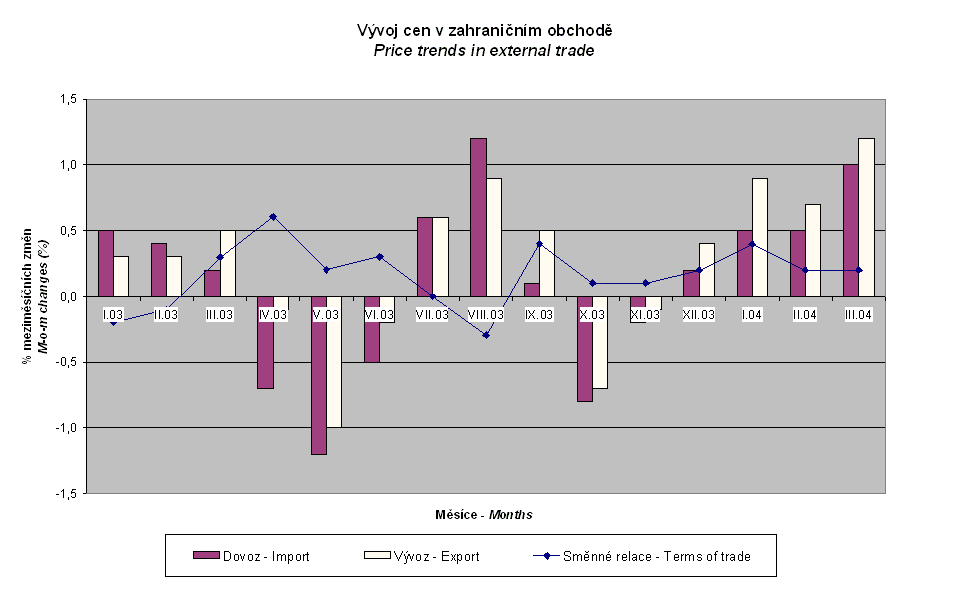Development of external trade price indices - 1. quarter of 2004
Product Code: e-7232-04
Development of external trade price indices in the first quarter of 2004
Month-on-month evaluation:
Both import and export prices were increasing during all the three months of the first quarter of 2004. In the quarter average they increased by 0.7% and 0.9%, respectively; in comparison with the fourth quarter of 2003 both of them increased by 1 percentual point. One of the reasons for this development is the influence of Czech koruna exchange rate in relation to main foreign currencies, especially to EUR and USD. While in the fourth quarter of 2003 in average when compared to the previous quarter CZK/EUR depreciated by 1.0% and CZK/USD appreciated by 5.9%, in the first quarter of 2004 the depreciation was already by 2.3% and appreciation only by 2.7%. From the comparison of the development of prices in the first quarter of 2004 with the fourth quarter of 2003 it results that the biggest differences occurred in ‘mineral fuels, lubricants and related materials,’ in which fall turned to grow and the difference thus was 3.9 and 4.1 percentual points for import and export, respectively. Similar development, though not so marked, the CZSO observed in the most significant group in terms of weight – ‘machinery and transport equipment,’ in which the difference was 0.4 and 0.7 percentual point, respectively.
Import prices were increasing month-on-month already since December 2003 and in individual months of the first quarter of 2004 they increased by 0.5, 0.5 and 1%, respectively. In February and March prices did not decrease in any of the measured groups. In the average for the first quarter of 2004 prices increased in all groups, the most in ‘crude materials, inedible, except fuels’ by 1.9%.
Also export prices were increasing month-on-month already since December 2003 and in individual months of the first quarter of 2004 they increased by 0.9, 0.7 and 1.2%, respectively. In this period, prices of all measured commodities increased in all the three months. The biggest increase in average occurred in ‘mineral fuels, lubricants and related materials’ by 3.2%.
Terms of trade were developing positively during the whole first quarter of 2004 and in average they reached the value of 100.2%. In comparison with the third quarter of 2003 their development was more favourable, with the exception of ‘crude materials, inedible, except fuels’. What was important for the level of total terms of trade was the substantial positive development in ‘machinery and transport equipment,’ in which the value of terms of trade reached the amount of 100.4% in the average for the first quarter of 2004. This value was thus by 0.2 percentual point higher than the total value of terms of trade and at the same time by 0.3 percentual point higher than in the previous quarter for the same group. Terms of trade were positive for all measured groups with the exception of ‘crude materials, inedible, except fuels’ in the average for the first quarter of 2004.
Year-on-year evaluation:
Import prices did not change year-on-year in the average for the first quarter of 2004, while export prices increased by 2.6%. The year-on-year development of external trade prices was similar to the month-on-month development: it was influenced by the development of the Czech koruna exchange rate in relation to main foreign currencies, especially to EUR and USD. While in the m-o-m development this influence was the factor, which clearly increased prices, for an evaluation of the y-o-y development the interpretation is more complicated. Czech koruna depreciated in the average for the first quarter of 2004 y-o-y in relation to EUR by 3.7%; however, in CZK/USD koruna appreciated by 12.1%, which was a similar development as in the fourth quarter of 2003 when CZK depreciated by 3.9% and appreciated by 14.3%, respectively. Due to the different weight of the two main foreign currencies in the external trade price index their exchange rate influence was basically eliminated in import, while in export the influence of foreign currencies exchange rate increased prices. Moreover, in export this influence was strengthened also by the development of koruna exchange rate in relation to GBP as CZK appreciated in this relation by 5.4% in the average for the fourth quarter of 2003 y-o-y, while in the first quarter of 2004 it depreciated by 2.3%.
Import prices were decreasing during the first two months of 2004 y-o-y (by 0.3% and 0.2%, respectively), in March they increased by 0.6%. One of the reasons for this different price development was also the different influence of koruna exchange rates in relation to the main foreign currencies in individual months of the first quarter of 2004. In January and February, koruna exchange rate did not change markedly y-o-y both in relation to EUR (depreciation by 3.8% and 3.7%, respectively) and USD (appreciation by 14.3% and 13.0%, respectively) and thus this influence was almost eliminated. In March, depreciation of koruna in relation to EUR remained the same as in February; however, in relation to USD koruna appreciated only by 9.3% and total exchange rate influences caused an increase of the import price index. From individual groups measured, prices for the first quarter of 2004 increased most in ‘crude materials, inedible, except fuels’ (by 5.8%, metalliferous ores and metal scrap, in particular, due to an increase of prices of scrap). On the contrary, the highest decrease (-10.9%) was measured at prices of ‘mineral fuels, lubricants and related materials’, especially petroleum and natural gas. Prices of these commodities at commodity exchanges were increasing in the period mentioned; however, the time lag between measuring of prices of these raw materials at world commodity exchanges and their input in our import has to be taken into consideration. Moreover, import prices of ‘mineral fuels, lubricants and related materials’ in comparison of y-o-y averages of the fourth quarter of 2003 and the first quarter of 2004 decreased by 9.9 percentual points, which is a very similar decrease as at prices of petroleum and natural gas on world commodity exchanges in the same period. From measured groups, decrease of prices in average for the first quarter of 2004 was observed only at ‘machinery and transport equipment’ and ‘miscellaneous manufactured articles’ (by 0.4% and 0.1%, respectively). However, both these groups decreased their fall by 0.9 percentual point when compared to the fourth quarter of 2003.
Export prices are increasing y-o-y already since April 2003. During the first three months of 2004 their growth accelerated and the y-o-y growth of the total index of export prices was gradually 2.1, 2.5 and 3.2%. The average growth for the first quarter of 2004 reached 2.6% (prices of all significant measured groups increased) and was thus by 0.9 percentual point higher than that of the previous quarter. The most distinctive growth occurred in prices of ‘mineral fuels, lubricants and related materials’ (by 7.7%, electric current, natural gas and coal, in particular). Prices of the most significant group of ‘machinery and transport equipment’ increased by 2.4% (‘office machines and automatic data-processing machines,’ in particular). It was by 0.2 percentual point less than the increase of the total index of export prices; however, the above-average increase of prices by 1.1 percentual point in comparison with the previous quarter markedly contributed to the overall acceleration of the export price index and thus also to the growth of terms of trade.
Terms of trade developed in the first three months of 2004 in a very favourable way and they gradually reached the values of 102.4, 102.7, and 102.6%. The average for the first quarter of 2004 was 102.6%, i.e. by 1.1 percentual point more than in the previous quarter. This value was the highest at ‘mineral fuels, lubricants and related materials’ (120.9%, electric current and natural gas, in particular), which was, however, influenced also by the time lag and the different structure of the import and export of this group. What had the most distinctive influence on the favourable value of total terms of trade was the group of ‘machinery and transport equipment’ (102.8%, ‘office machines and automatic data-processing machines,’ in particular). From significant groups, unfavourable terms of trade were measured in the first quarter of 2004 only at ‘crude materials, inedible, except fuels’ and ‘manufactured goods classified chiefly by material’ (96.7% and 99.4%, respectively).
The world price index of raw materials and food continued to slow down its quarterly y-o-y growth. This trend started already in the first half of 2003. In the first quarter of 2004, the growth was already only 5.5% and was thus by 7.2 percentual points lower than that of the previous quarter. This change was caused mainly by the development of prices of petroleum and natural gas, the total growth of which decreased from 13.8% to 3.5%, i.e. by 10.3 percentual points, which was by about the same value as at import prices of ‘mineral fuels, lubricants and related materials’ in the same period. Especially y-o-y indices of petroleum prices at world commodity exchanges underwent in the first months of 2004 a rapid development – in January they increased by 1.2%, in February dropped by 5.5% and in March they grew again by 10.6%. Especially the development of prices in 2004 itself was reflected in it as well as sharp changes in prices in the beginning of 2003 in relation to the war in Iraq.
Elaborated by: Prices Statistics Department
Director: Jiří Mrázek, tel. (+420) 27405 2533



